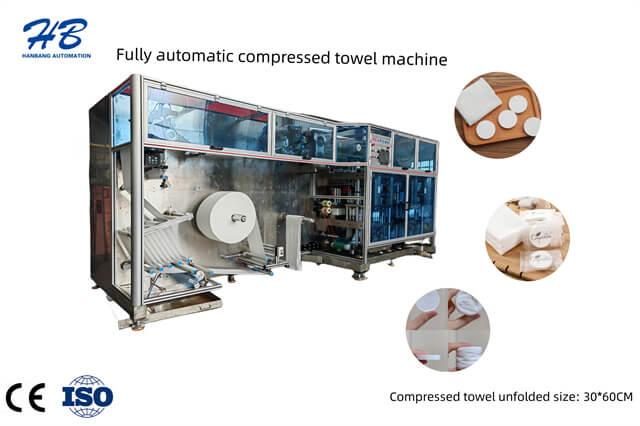Author:HB Nonwoven MachineryFROM:Compressed Towel Machine Manufacturer TIME:2023-11-27
Introduction:
The maintenance and care of nonwoven fabric slitting rewinding machines are crucial in the hygiene product industry, particularly for the production of diapers and sanitary napkins. These machines play a critical role in ensuring the efficient and accurate slitting and rewinding of nonwoven fabrics, which are essential components of these products. Regular maintenance and proper care not only enhance the longevity and performance of the machine but also contribute to improved productivity and product quality. In this article, we will explore the key aspects of maintaining and caring for nonwoven fabric slitting rewinding machines.

Regular cleaning and lubrication are essential for the smooth functioning of nonwoven fabric slitting rewinding machines. Dust, debris, and adhesive residue can accumulate on the machine's surfaces, affecting its performance and accuracy. It is crucial to clean the machine thoroughly using appropriate cleaning agents and tools. Lubricating the machine's moving parts, such as bearings, gears, and shafts, helps reduce friction and wear. Proper lubrication also minimizes the risk of breakdowns and extends the machine's lifespan.

Adhering to a regular inspection and maintenance schedule is vital to identify potential issues and prevent major breakdowns. Inspect the machine's components, including blades, rollers, and sensors, to ensure they are in good condition. Replace any worn-out or damaged parts promptly. Additionally, check the tension control system and adjust it if necessary. Establish a maintenance schedule, including routine inspections, cleaning, lubrication, and part replacements, to ensure the machine operates optimally.

Proper training of machine operators is essential to guarantee the effective and safe operation of nonwoven fabric slitting rewinding machines. Operators should have a comprehensive understanding of the machine's functions, controls, and safety measures. Regular training sessions can help operators stay updated with the latest technological advancements and best practices. Additionally, monitoring operators' performance closely can help identify any deviations or mistakes, enabling immediate corrective actions.
The blades on a nonwoven fabric slitting rewinding machine are subjected to considerable wear and tear. Dull or damaged blades can result in uneven cutting and compromised product quality. Regularly inspect the blades and sharpen or replace them as needed. Maintain a stock of spare blades to ensure uninterrupted production. Following proper blade sharpening and replacement procedures not only ensures optimal cutting performance but also safeguards the machine and reduces the risk of accidents.
The electrical and electronic systems in nonwoven fabric slitting rewinding machines require regular maintenance and care. Check the wirings, connections, and control panels for any signs of damage or malfunction. Replace faulty components and circuits promptly to prevent further damage. Additionally, keep the machine's software updated and perform periodic checks to ensure its compatibility and functionality. Regular calibration of sensors and actuators is also crucial for accurate and precise operations.
Safety should be a top priority when operating and maintaining nonwoven fabric slitting rewinding machines. Implement comprehensive safety measures and protocols to protect operators and prevent accidents. Ensure that operators wear appropriate personal protective equipment (PPE), such as gloves and safety glasses. Clearly label emergency stop buttons and provide training on emergency response procedures. Regularly inspect and maintain safety devices, such as guards and sensors, to ensure their effectiveness.
Regular calibration and alignment of nonwoven fabric slitting rewinding machines are essential to maintain accurate and consistent cutting and rewinding results. Calibrate the tension control system to match the desired settings for different types of nonwoven fabrics. Align the blades, rollers, and guides properly to ensure precise cutting and rewinding. Regularly check and adjust the machine's settings and parameters based on product specifications and quality requirements.
Maintaining comprehensive documentation and record-keeping systems is crucial for the maintenance and care of nonwoven fabric slitting rewinding machines. Keep records of all maintenance activities, including inspections, cleaning, lubrication, part replacements, and calibrations. Document any issues or incidents and the corresponding corrective actions taken. This documentation helps track the machine's performance, identify recurring problems, and plan preventive maintenance effectively.
In conclusion, proper maintenance and care are essential for nonwoven fabric slitting rewinding machines used in the diaper and sanitary napkin industry. Regular cleaning, lubrication, inspection, and maintenance are necessary to ensure optimal performance, longevity, and product quality. Operator training, blade maintenance, electrical system care, and adherence to safety protocols are equally important. By implementing these maintenance practices and incorporating a robust documentation system, manufacturers can maximize the efficiency and reliability of their nonwoven fabric slitting rewinding machines.





